|
|
|

|
|
|
|
As to approach the animals in wildlife
|
|
|
|
Text and photos by Ernesto Francini
|
|
|
|
|
|
|
To do nature photos, for professional
purpose or hobby, often, above all when it is the first experience, and the
photographer have not sharpened again the abilities of approach to the varied
animal kinds, it is difficult to realize good photographic documentation's,
in special mode, of the present fauna in Italy.
The innate distrust of these living
beings towards the man, that has tried with every mean to persecute and to
chase them for centuries, makes difficult every attempt of direct and
spontaneous approach.
The development of an approach
technique, above all if it is personnel and the result of continuous
experiences lived directly on the field, jointly with the use of appropriate
means, it is therefore advisable to reach the desired results.
The knowledge of the varied animal
kinds that is desired to document must first of all to begin from the study
of them through the existing bibliography, which will have to give us in first
place all the preliminary information, related to the characteristics and
to the behavior of the subject.
That will be the departure base of our
search.
Often the animal is repetitive, and as
every other living being it organizes its day devoting itself to carry out
all the varied activities as each of us is usual to do.
Then if the subject is for instance a
bird, the first suggestion is to try to locate the nest zone, in this way
we will have a firm point of reference from which the animal will have to
transit surely.
The observation of the nest can be
effected only with previous permission released by the local authority,
designed to watch the territory in which is placed the nest-building
area.
Waiting for us in the proximities of
the nest we can study better its habits, when it leaves the nest for the
hunting, when it returns and when it is rested.
We will notice that it often maintains
the same schedules and the same habits and this will allow us to organize
better our job.
The approach to the nest must have
done using a transportable mimetic tent, or creating a fixed hiding place,
camouflaged between the bushes and the vegetation that constitute the
environment.
If we use a transportable mimetic
tent, it must be positioned in the nest proximities and left there for
several days on the place, before the use, with the purpose to accustom the
animals to it presence, better still if it will be covered with leaves,
twigs and anything other than makes it less visible and mostly integrated
in the environment.
Besides it is advisable to accustom
the birds to the camera lens presence, leaving a bottle
or a cardboard cylinder, of similar
color, inserted in the tent slits.
It is important to note that we will have
to access the hiding place or tent before the dawn only and the exit from
it will have to happen only with the dark.
Let's not forget us that some animals,
in special way the birds, have a sight more acute than our and they are
very careful to perceive every something happens in their proximities, not
to respect these rules could jeopardize every our effort and to make
useless and vain our long waits inside the tent.
To attract the animals mostly could
also be predisposed a manger, positioned to the correct distance to get
from our lens the best frame, if possible predisposing a branch of tree
above it that can act as perch for the bird that comes to feed.
In the case of carnivorous animals
(herons, rapacious and other predatory birds) the manger will be able to
have fed with discards of meat and fish, while for the sparrow type birds
we can use some bread, crumbs of sweets, walnuts, peanuts and seeds.
|
|
|
|
|
|
|
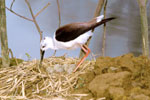
|
|
|
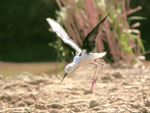
|
|
Black-winged stilt
at the nest
(Himantopus himantopus).
|
|
|
Black-winged stilt
in landing
(Himantopus himantopus).
|
|
|
|
|
|
|
|
However I would like to notice that any
action we undertake, approaching us to a nest, this doesn't have to leave
out of consideration the respect toward the animal and its
environment.
If approaching us to the animal it
realizes our presence and it shows signs of impatience or discomfort it is
opportune that we abandon our enterprise avoiding to worsen the situation.
In the case in the nest there are
chicks, it is necessary to take into consideration that they will normally
be abandoned by their parents, which in front to a possible raider, as the
man, to which they cannot face, they can only to run away. Until the raider
will persist with its presence they will never return to the nest and the
chicks cannot have food.
There are besides atypical and extreme
cases that is necessary to recognize immediately acting accordingly.
It was spring, I had to document, to
study, the habits and the life of the Purple herons, then
I had gone in an oasis. After having
located a beautiful sample of this
animal, steady on a willow-tree bush, using the binoculars that I always
bring with me, I had begun slowly to approach me to it,
trying to put in action all the
possible precautions to don't disturb and to frighten the animal.
I had arrived to around 15 meters of
distance, an excellent distance for my lens, and the animal, which it had
not realized my presence yet, it was quiet and it didn't give some sign of
impatience.
I now had to choose a stable position
in which to wait for me to photograph and since between me and the heron
there was a ground depression with a water stream I had decided to come
down to its edge to go behind a bush set on the bank.
Unfortunately, during the descent, I
slipped suddenly on the ground creating a great bustle.
I was completely lying down at ground,
been sorry however happened, aware that surely this noise had alarmed and
let escape the present birds and all my work had been vain.
Desolate I got up and I put sat on the
ground, worrying me exclusively do not have damaged the camera and lens,
since I knew that the whole rest was lost.
But when I finally lifted the eyes,
with my great astonishment, I noticed that the Purple heron was still
there. I didn't succeed to understand how this was possible, it had
realized now my presence and I was completely to the open one.
Quiet I drew near to the bush that I
had individualized and with the binoculars I began to observe the
environment around the animal.
Now everything was clear, in the lower
parts, hidden between the willow-tree branches, there was a
nest with two chicks newly-hatched,
the heron had not wanted to abandon them.
Taken my things and I went away in the
more possible hurry.
|
|
|
|
|
|
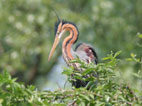
|
|
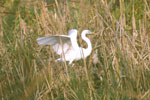
|
|
Purple heron (Ardea purpurea).
|
|
Great white egret
near the nest
in a cane thicket
(Egretta alba).
|
|
|
|
|
|
|
The technique to approach the animals
in the open space, without camouflage, is surely that more difficult to
effect but, without doubt, it can assure great satisfactions.
To draw near to wild animals to the
open one, as for instance the birds, are practically impossible, but if a
person possesses a good dose of patience, also this technique sometimes can
give good results.
Personally I believe that the animal
possesses a more great sensibility than the human being and it knows how to
recognize, in the time, the good or bad intentions present in our mind.
To draw near to them with a well
prepared mind in their comparisons, letting them feel, with our behavior
that we don't want do them something of badly, it cannot do anything else other than to lower
progressively the barriers that divide us from them making them aware of
our good intentions.
Between the most sensitive birds there
is the European Crane, a bashful and mistrustful animal, otherwise from
other birds, of analogous dimensions, it normally interposes a great escape
distance from the possible raider, and at every least suspicious noise it
is ready to steal.
To document these birds
photographically, if we do not have a well camouflaged hiding place, it
becomes difficult and practically impossible.
I desired to photograph them, and
although aware of these difficulties I wanted to do this in the more simple
way, that is approaching me to them to the open one without camouflages.
I wanted to do this to feel a new
experience, because I love the animals, because I am a person that as a lot
of other persons look for a direct contact with these marvelous living
beings, feeling joy when this happens, since I believe firmly that the man
and the animals have to cohabit, on this planet, in quiet and peaceful
mode, without fearing the one with the others.
I had individualized the territory of
a beautiful couple of these birds and I began so to practise a direct
approach.
Every time that I drew near them they
got further, maintaining the correct escape distance
to fly off in safety condition.
The male following a typical behavior
of the kind, after having gotten further, it had taken
off in flight and it turned in round
to tall altitude, above the position in which I was, for different minutes,
to check better me and to understand what dangers it had in front.
This situation has repeated for some
months without I could effect some decent photos (the birds were too
distant from me). Until when one day repeating the usual ritual of
approach, always very slowly, footstep after footstep, I has noticed that
they didn't get further more.
They had understood that I didn't want
to make some badly.
I have remained so a lot of time
nearby enough to them with the opportunity to shoot all the photos
that I wanted to do.
In conclusion I would like to
synthesize my personal thought.
In the naturalistic photography will
have more success the most prepared photographer in the naturalistic field,
who will have the better knowledge in the intimate aspects of the the
animals life and habits, not sure the best photographer from the technical
point of view in the use of his equipment's.
|
|
|
|
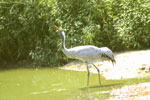
|
|
Crane (Grus grus).
|
|
|
|
|
Recommended bibliography:
- Peterson, Mountfort, Hollom - A field guide to the Birds of
Britain and Europe.
William Collins & Sons Ltd London.
- Bertel Bruun, Arthur Singer - Birds of Britain and Europe.
Hamlyn Publishing Group Limited.
- Colin Harrison
- Nests, eggs and
nestlings of British and European birds.
Guide
to the recognition.
William Collins & Sons Ltd London.
|
|
|
|